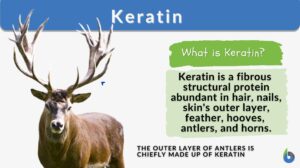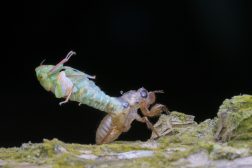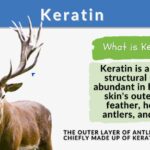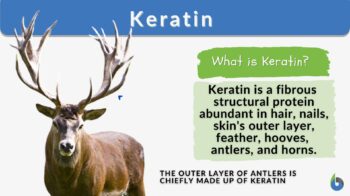
Keratin
n., plural: keratins
[ˈkɛrətɪn]
Definition: Structural protein found in hair, nails, and outer layer of skin
Table of Contents
Keratin is a fibrous protein naturally present in hair, skin, and nails. In hair care, it serves as a protective and structural element, enhancing strength and smoothness while reducing frizz. Keratin treatments aim to replenish and fortify hair’s natural keratin content, resulting in healthier, more manageable locks. Read on to learn more about keratin, its definition, examples, genetics, structure, and significance in biology and medicine.
What Is Keratin?
Keratin is a natural fibrous structural protein that forms an integral part of human hair, nails, and skin and is characterized by its intricate secondary structure. Comprising alpha helices, this alpha keratin forms a robust framework, which is a fibrous and structural protein consisting of polypeptide chains that intertwine to create a sturdy and resilient framework.
The amino acids that make up keratin also change depending on where it is found and what it does. Cysteine residues are especially important because they make cystines (a type of chemical bond when disulfide bonds link cysteine residues together covalently). Keratin is very stable because of the cysteines in it.
Keratin is insoluble in warm as well as in hot water and is unaffected by proteolytic enzymes. Fully hydrated keratin filaments (about 16 percent water) are 10 to 12 percent longer than those that are dehydrated.
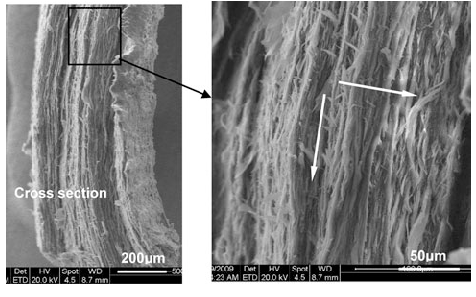
Watch this vid about a type of keratin, alpha-keratin:
Biology definition:
Keratin is a fibrous structural protein abundant in hair, nails, skin, feathers, hooves, horns, and so on. Keratins are made up of coiled polypeptide chains and when they combine they form supercoils. Keratins protect epithelial cells from damage.
Skin cells that are constantly exposed to pressure and rubbing leads to the formation of calluses. The skin thickens and the epidermal cells undergo cornification. Cornification is a process in which a keratinized layer of epidermis forms and serves as an epidermal barrier. During cornification, keratin fills up the cell resulting in the loss of cytoplasmic organelles and the cessation of metabolism. Ultimately, the fully keratinized cells undergo programmed cell death.
Overview:
Keratin is one of the types of scleroproteins or fibrous proteins. Scleroproteins, in turn, are one of the three major types of proteins (the other two are spheroproteins and membrane proteins). Scleroproteins are characterized by their long protein filaments. They act as structural proteins. They are usually water-insoluble. Apart from keratin, other examples of scleroproteins are collagen, elastin, and fibroin.
Etymology: from German “keratin”, from Ancient Greek “κέρας” (kéras), meaning “horn” + -in.
Examples Of Occurrence
Keratin filaments are widespread within keratinocytes throughout the entirety of the cornified layer of the epidermis. Additionally, they are found in every epithelial cell. For instance, antibodies against keratin 8, keratin 5, and keratin 14 react with murine thymic epithelial cells. Antibodies of this type have been utilized as fluorescent markers in a genetic study of the thymus of rats.
Both vertebrates have keratin in their bodies. The slime threads of hagfish and the hair fiber, nails, wool, claws, epidermis, horns, and hooves of mammals all contain keratin.
Only sauropsids, which include all living reptiles and birds, have keratin. Various animal parts, including beaks, feathers, and talons of birds, as well as the scales, nails, and claws of reptiles, are embedded in them.
In the antlers of animals like the impala, keratin covers a bone core.
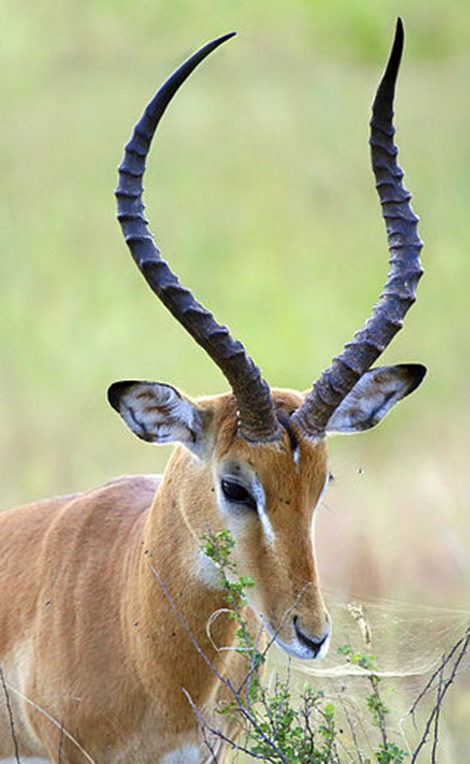
Genes
On chromosomes 12 and 17, there are two distinct clusters containing a total of 54 functional keratin genes. This suggests that their genesis can be attributed to a series of gene duplications on these particular chromosomes. The keratin genes are clustered on different chromosomal loci and are distributed across multiple chromosomes.
The expression of keratin genes is tissue-specific and regulated by various factors, including developmental stages, environmental cues, and cellular differentiation. Keratins play a critical role in maintaining the structural integrity of various epithelial tissues. Mutations in keratin genes lead to different disorders such as epidermolysis hyperkeratosis, Areata Alopecia, Keratosis pharyngitis, and Simplex Epidermolysis Bullosa.
Protein Structure
During the years 1982 and 1983, Elaine Fuchs and Israel Hanukoglu made a significant breakthrough by uncovering the primary sequences of keratins. These sequences provided compelling evidence for the presence of two distinct yet closely related keratin families, known as type I and type II keratins. Hanukoglu and Fuchs put forth a conceptual model suggesting that keratins and intermediate filaments proteins contain a central domain that extends across 310 amino acid residues. This domain is comprised of four segments anticipated to adopt an alpha-helical structure, alongside three concise linker segments predicted to assume a beta-turn conformation.
Type 1 and 2 Keratins
Within the human genome, 54 keratin genes have been categorized based on their functional roles. Among these, 28 are found in type 1 and the remaining 26 in type 2.
- Type I keratins are typically smaller and more acidic proteins. This type is essential for maintaining the integrity of epithelial cells.
- Type II keratins are relatively massive, neutral pH proteins.
Disulfide bridges
Apart from intramolecular and intermolecular hydrogen bonds, keratins exhibit a notable abundance of the amino acid cysteine, containing sulfur, which is crucial for forming disulfide bridges. These bridges impart enhanced stiffness and lasting strength through enduring, thermally stable linkages, similar to how non-protein sulfur bonds enhance the stability of vulcanized rubber.
Roughly 14% of the human hair cuticle consists of cysteine. When hair and epidermis burn, they release distinct odors due to volatile sulfur compounds. The substantial disulfide bonding makes keratins insoluble in the absence of certain dissociating or reducing agents.
Comparatively, the keratins present in hair, which are more pliable and supple, possess few inter-chain disulfide bridges as compared to the keratins found in the nails, horns, and claws of mammals, which tend to be more rigid.
Hair and α-keratins are constructed from individual protein strands coiled in an α-helical manner which are then intertwined into superhelical chains that can undergo further coiling.
In reptiles and birds, the disulfide bridges within their keratins serve to anchor and fortify their β-pleated sheets, which are subsequently intricately intertwined.
Filament formation
Keratin filament formation is the process of assembling keratin proteins into complex structures within cells, contributing to the strength of tissues like skin, hair, and nails. This involves the arrangement of keratin molecules into dimers, tetramers, and higher-order structures, guided by alpha-helical segments and disulfide bridges formed by sulfur-containing amino acids. This process is regulated by factors such as tissue type, cellular differentiation, and environmental cues. The resulting filaments provide tissues with mechanical resilience against stress.
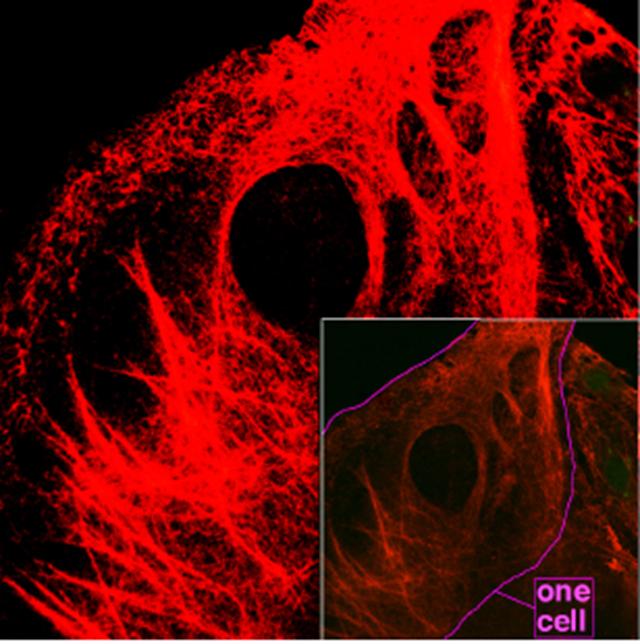
Pairing
Keratins can be classified into two categories:
- Neutral-Basic
- Acidic
These keratins are associated with specific occurrences in various tissues.
- For instance, keratin 1 and keratin 2, along with keratin 9 and keratin 10, are found in the stratum corneum and keratinocytes.
- Keratin 3 and keratin 12 are present in the cornea
- Keratin 4 and keratin 13 are associated with stratified epithelium.
- Keratin 5, along with keratin 14 and keratin 15, is found in the stratified epithelium as well.
- Keratin 6, keratin 16, and keratin 17 are linked to squamous epithelium.
- Keratin 7 and keratin 19 are present in ductal epithelia, and keratin 8, keratin 18, and keratin 20 are associated with simple epithelium.
- The distribution of these keratins in specific tissues showcases their diverse roles in maintaining tissue integrity and function.
| Neutral – Basic | Acidic |
|---|---|
| keratin 1, keratin 2 | keratin 9, keratin 10 |
| keratin 3 | keratin 12 |
| keratin 4 | keratin 13 |
| keratin 5 | keratin 14, keratin 15 |
| keratin 6 | keratin 16, keratin 17 |
| keratin 7 | keratin 19 |
| keratin 8 | keratin 18, keratin 20 |
Data Source: Shoaib Zaheer of Biology Online
Cornification
Cornification is the formation of an epidermal barrier consisting of a horny layer of the epidermis. The production of keratin characterizes it. In addition to keratin production, cornification involves the production of minor proline-rich proteins and transglutaminase.
Under the plasma membrane, this results in the development of a cornified cell envelope. During the final phases of cornification, the cells shed their organelles, including their nuclei, and fill with keratin. Consequently, this results in a shutdown of metabolism. The completely keratinized cells eventually undergo programmed cell death.
On the skin’s surface, cells undergo cornification, particularly epidermal cells, and become nearly impermeable. The result is an epidermal barrier that is both rigid and elastic. Persistent scratching and pressure on the cornified layer result in further thickening and callus formation. However, since epidermal cells are continually shed and replaced, calluses may dissolve when pressure is removed.
Silk
It is a fibrous material composed of keratin proteins, typically produced by certain insects and spiders. but their evolutionary connection to keratins found in vertebrates remains ambiguous.
Typically, spider silk measures between 1 and 2 micrometers (µm) in thickness, in contrast to roughly 60 µm for human hair and even greater dimensions for specific mammals.
The valuable characteristics of silk fibers, both in biological and commercial contexts, are intricately tied to how multiple protein chains are structured. These chains are structured into compact, crystalline segments of varying dimensions, intermingled with pliable, amorphous regions where the chains intertwine randomly. This structural pattern is somewhat reminiscent of what occurs with man-made polymers like nylon, which was developed to emulate silk.
In the case of silk obtained from hornet cocoons, it comprises pairs of structures that are approximately 10 µm in width. These structures consist of central cores and outer coatings, and they can be stacked in layers, sometimes up to 10 layers thick. These layers can also form variedly shaped plaques. Interestingly, fully grown hornets employ silk not only as a material for creating intricate structures but also as an adhesive, much like how spiders use silk.
Glue
Hoof glue and horn glue, both of which are formed from partially hydrolyzed keratin, are animal-based proteins. These proteins are broken down through a process called hydrolysis, which involves the use of heat and chemicals to break the complex protein structures into smaller fragments.
Hoof Glue
Hoof glue is derived from the hooves of animals, typically cattle. It has been used for centuries in woodworking, bookbinding, and other crafts due to its strong adhesive properties, ease of use, and ability to bond well with various materials.
Horn Glue
Horn glue, similarly, is derived from the keratin protein found in animal horns. The process of producing horn glue is similar to that of hoof glue. Horn glue has been historically used for various applications, such as in the production of musical instruments, artwork, and even as an adhesive in ancient construction.
Clinical Significance
Protein-based biomaterials have surfaced as a promising substitute due to their inherent capacity for cellular interaction, structural reinforcement, and intercellular communication. Over the past century, advancements in the extraction, purification, and analysis of keratin proteins from sources like wool, feathers, antlers, and other animal-derived materials have paved the way for the creation of a foundation for keratin-oriented biomaterials.
With attributes akin to substances that the body produces naturally, keratins display inherent biological activity and compatibility.
Isolated keratins possess the ability to self-assemble into structures that play a role in cellular recognition and behavior modulation. It is these attributes that have led to the innovation of keratin-based biomaterials with applications spanning wound healing, pharmaceutical delivery, tissue engineering, trauma care, and medical apparatus.
Extensive research delves into the historical context of keratin investigation and the current landscape of novel methodologies in medical domains such as medical science, tissue engineering, regenerative medicine, and pharmaceutical delivery, all focused on comprehending keratin’s functionality within the human body.
Certain conditions can lead to abnormal keratin development, encompassing keratoderma, hyperkeratosis, and keratosis. Various ailments, such as athlete’s foot and ringworm, stem from fungi that feed on keratin.
Keratins play a pivotal role in modern hair cosmetics. They help maintain the strength and integrity of hair, reduce frizz, and hair loss, and promote healthy hair growth. Keratin treatments (e.g., Brazilian Blowouts) have gained popularity in hair salons and beauty supply stores due to their ability to transform frizzy and damaged hair into smoother and more manageable locks.
These treatments typically involve the application of a liquid keratin solution to the hair, which is then sealed using a flat iron. The heat helps in bonding the keratin to the hair, making the hair healthier in appearance.

It’s worth noting that some traditional keratin hair treatments (chemical protein treatments) cause formaldehyde exposure, which raised concerns about exposure to harmful chemicals. In response, newer formulations have emerged, focusing on safer methods for achieving the desired results.
Additionally, keratin supplements and hair products like keratin oils, and conditioners infused with keratin aim to support hair health from within, providing the building blocks necessary for keratin production and cell growth.
As science continues to explore the benefits of keratin, innovations like feather keratin hydrolysates obtained from sustainable sources have introduced environmentally friendly options that further contribute to the hair care landscape. However, excessive use of keratin solutions and treatments can lead to the accumulation of keratin residues that may eventually result in keratin clogs, impeding hair growth and health.
How does keratin treatment work on hair?
Human keratin is a natural protein found in human hair. Keratin in hair, thus, has a vital role in maintaining hair strength and resilience. Keratin treatments are effective on hair due to the protein’s ability to bind to the hair shaft, filling in gaps and creating a smoother surface.
This results in reduced frizz, increased shine, and improved manageability. These effects are often achieved, though, by delaying hair washing after about 48 hours. This time frame is essential to ensure longer-lasting outcomes as it would allow the keratin molecules in the treatment to properly adhere to the hair and continue the process of polymerization.
Remember how the keratins are formed by disulfide bridges as mentioned earlier? This is one of the reasons shampoos that are sulfate-free are recommended for in washing keratin-treated hair. Sulfates, especially strong ones, can break down disulfide bridges in keratin proteins. The effects, however, eventually weaken over time, lasting typically around three months.
Diagnostic use
The manifestation of keratin aids in recognizing the epithelial source of anaplastic malignancies. Carcinomas, thymomas, sarcomas, and trophoblastic tumors are among the malignancies that exhibit keratin expression.
Moreover, the specific sequence of keratin subtypes being expressed allows for the anticipation of the primary tumor’s source when assessing metastatic instances. Cholangiocarcinoma typically expresses CK7, CK8, and CK18, whereas hepatocellular carcinomas typically express CK8 and CK18. However, metastases of colorectal carcinoma express CK20 but not CK7.
Take the Keratin – Biology Quiz!
References
- BiologyOnline. (2023). Cornification. Retrieved 14 August, 2023, from https://www.biologyonline.com/dictionary/cornification
- Gregersen., E. (2023). keratin. Retrieved 14 August, 2023, from https://www.britannica.com/science/polymer/Synthetic-polymers
- Sarma, A. (2022). Biological importance and pharmaceutical significance of keratin: A review. International Journal of Biological Macromolecules.
- Vedantu. (2023). Keratin. Retrieved 14 August, 2023, from https://www.vedantu.com/biology/keratin
©BiologyOnline.com. Content provided and moderated by Biology Online Editors.

